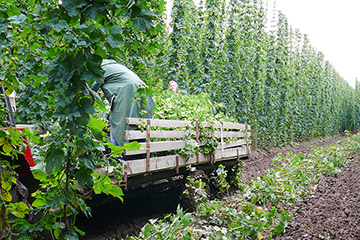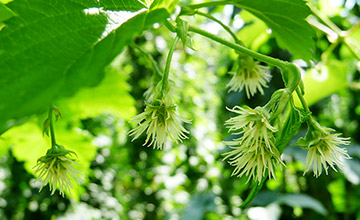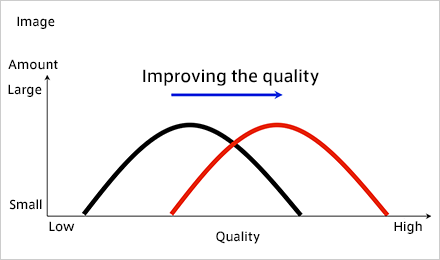- Suntory Global Innovation Center
- > Research & Technology
- > First in the world to unravel the hop draft genome
Research & Technology
First in the world to unravel the hop draft genome
Hop (Humulus lupulus) is an indispensible ingredient in beer, giving it its characteristic aroma and flavor. SIC took up the challenge of determining the sequence of the hop genome, and was the first in the world to succeed. Read on to learn what we found out as well as the exciting new possibilities for the future.
Suntory is passionate about crafting delicious beer, and this passion makes us want to know more about the essence of beer ingredients. We therefore decided to study them from the very beginning—starting with the raw materials.
Hops are critical ingredient that gives beer its fragrance, bitterness, and other flavors. The Premium Malt’s is brewed with carefully selected fine aroma hops grown in the Saaz region of the Czech Republic. The floral aroma that The Premium Malt’s is known for comes from these Saaz hops.

Securing a reliable supply of high-quality hops—particularly Saaz hops—is becoming more difficult, however, due to recent environmental changes and the growing demand for beer that is accompanying the world’s ballooning population. Sustainably ensuring the required amount of hops is an important task. In an effort to address this issue, the Suntory Global Innovation Center Ltd. (SIC) has been working with the Hop Research Institute in the Czech Republic since 2010 to understand the genome, which is the blueprint for hops.
Sequencing the hop genome requires cutting-edge equipment and informatics capable of handling massive amounts of data, while only existing hop varieties can be analyzed. Our team chose to sequence the genome DNA of a Japanese cultivar, Shinshu Wase (SW). The size of the hop genome is estimated at around 2.5 billion base pairs, approximately equivalent to sixty-two years’ worth of newspapers (assuming 110,000 letters in a typical morning edition). By using the latest DNA sequencing devices, including next generation sequencers, SIC have successfully determined about 2.0 billion base pairs, corresponding to 80% of the estimated total size. Based on this huge amount of genetic information for SW, we reconstructed the genome sequences of the European ‘Saaz’ cultivar and a Japanese wild hop (H. lupulus variety cordifolius). Our study led us to discover the numerous genetic differences among these three types of hop.

Through gene expression analysis during the development of female hop flowers (the hop “cones”), we partly revealed the mechanism that leads to the generation of characteristic hop aromas and flavors. We also discovered that genes responsible for flavor are active at the youngest stages of cone development, and that genetic activity differs markedly across hop varieties. Differential gene expression is basically derived from the genome, resulting in the different aromas and bitterness in distinct hops varieties.

- Reference
- Natsume, S. et al. (2015) The draft genome of hop (Humulus lupulus), an essence for brewing Published in Plant and Cell Physiology 56, 428-441 (Oxford University Press).
This hop genome work was elected as a research highlight and was on the cover of the volume of March 2015 56 (3), Plant and Cell Physiology.

Like grapes, coffee, tea, and other beverage crops, the quality of hops varies greatly depending on the harvest year, soil characteristics, and so on. Factors like weather fluctuations during the growing season, the age of the plants, disease, and the timing of the harvest are all known to impact flavor—so we attempted to identify exactly how each of them actually impacted hop character and quality.
We found that plant age affects the quality of hop cones; younger plants produce milder, woody aromas, while middle-aged plants around ten years old produce more floral aromas. These results were confirmed by sensory evaluations, indicating that creating the ideal flavor profile requires not only managing harvested hop conditions (post-harvest), but also controlling hop cultivation appropriately.

- Reference
-
H. Matsui, T. Inui, M. Ishimaru, Y. Hida, and K. Oka. The influence of hop root age on the quality of hop aromas in beer. Beer Development Department, Beer Division, Suntory Liquors Limited
Presented at the 2012 International Society for Horticultural Science (ISHS), 3rd International Humulus Symposium (Proceedings of the Third International Humulus Symposium, p171-182)
Genome studies can lead us to understand what environmental factors influence hop quality. For example, by comparing whole gene expression profiles in the same hop plant between good and bad quality years, we may be able to identify which genes are necessary for enhancing certain qualities and then find ways to control them, leading to stable and high-quality hop production. In other words, by continually collecting and analyzing this data and putting it to work in hop cultivation, we will soon be able to more actively apply our findings to the production of high-quality hops.

The genome encodes all sorts of biological information, such as resistance to pathogens, flowering time, and aromas. If we want to achieve stable production of high quality hops, for example, it is important to specify which parts of the huge genomic DNA are associated with the characteristics of interest.
Comparing the genetic information of the domesticated hop cultivar SW to that of the wild hop KR, we found that over 1500 genes were enriched in the SW cultivar during the historical domestication process. Some of the 1500 genes were found to be critical factors in enhancing aroma and bitterness in the hops, probably reflecting to our preferential selection of suitable hop characters for brewing.
Unraveling the hop genome leads understanding essence of the hop nature that nobody has understood before. Using findings from genomic information, we are developing practical cultivation techniques for the production of high quality hops. It is a big challenge that requires patience, but also highly fruitful project. Suntory is now cooperating with hop growers to help create even more excellent beer.

* The department name, title, and photo are as of the time of the production (interview).
* The department name, title, and photo are as of the time of the production (interview).






